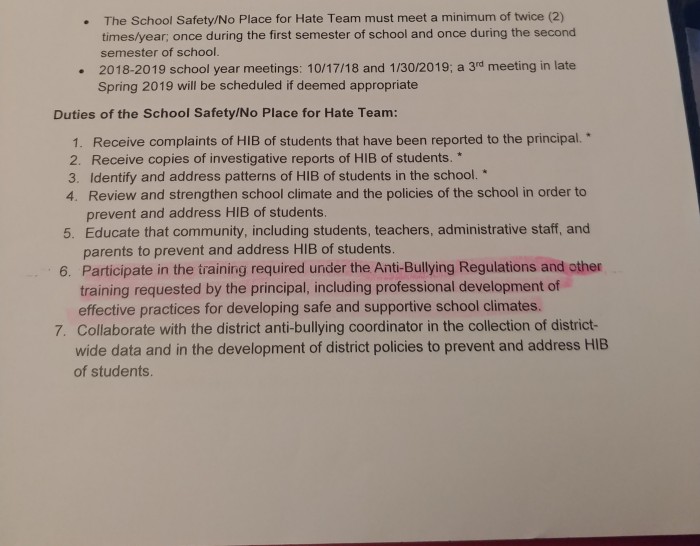The teacher engages in ongoing professional learning and uses evidence to continually evaluate his/her practice, particularly the effects of his/her choices and actions on others (learners, families, other professionals, and the community), and adapts practice to meet the needs of each learner.
Teaching is a continuous learning opportunity. A teacher does not simply student teach and learn everything he or she needs to be an effective teacher. There is an infinite number of strategies teachers can learn to improve his or her practice. Teachers must seek out those opportunities to help them learn those strategies to become more effective in their practice. Not only should teachers find opportunities to help them become more effective in teaching, but they should also look for opportunities to be better community members. Teachers do not simply teach language arts, math, science, and/or social studies. They are also advocates for making the community within the school a better place. Therefore, they must also find ways to become ethical citizens within the school.
Developing Healthy Classrooms with Less Stress and More Flexibility
This year, I had the pleasure of going to the NJEA Convention for an opportunity in professional learning. I was glad I went because I always wondered what I would do for those students with behavior issues. When attending the convention, my best friend and I looked for workshops that would help us with classroom management and monitoring behavior. My first artifact is a certificate from a workshop I attended at the convention called “Developing Healthy Classrooms with Less Stress and More Flexibility.” I chose this artifact because I thought of all the workshops I attended at the convention, this one was the workshop from which I learned the most. From this workshop, I learned a strategy that may help students with behavior issues decrease the undesired behaviors and make those students want to learn. The strategy is called a Matrix for Psychological Flexibility, which allows students to evaluate who or what is important to them and what shows up inside of them and gets in the way. Then, students evaluate what they do to get away from what shows up inside of them and what they can do to move toward who or what is important to them. I thought that this was an effective strategy because it allows students to see some of their behaviors on paper and evaluate them. Furthermore, it allows them to see their purpose and how they can achieve that purpose. While I was at this workshop, the instructor told us that when students do this, they enjoy it because it shows that the teacher is concerned about who they are, and they realize what they need to do to get to who or what is important to them. Furthermore, it allows students to realize that the things they are doing to get away from whatever shows up inside of them relieves them, but it does not help them achieve their goal. While I was sitting in this workshop, I was wondering how it could be used for first-graders. My question was answered when the instructor showed us that they can draw their answers rather than write them. This artifact is significant because it shows that I went to this workshop at the NJEA Convention to learn about this behavior management strategy that I will definitely use in my classroom in the future regardless of which grade I teach.

As a teacher, the teacher is not just a teacher; the teacher is an activist as well. As an activist, the teacher is a public figure in the school and the community who must promote school and community values. My second artifact is a handout I received from attending the School Safety/No Place for Hate meeting. On the handout are the team members, the duties of the School Safety/No Place for Hate Team, and the agenda. Both of my cooperating teachers are members of the School Safety/No Place for Hate Team, and my general education cooperating teacher told me about this meeting and asked me if I wanted to go. I said yes because these were the meetings I would attend as a teacher. She told me the meeting was an anti-bullying meeting, and I was intrigued to see how these issues were handled. In this meeting, we talked about how we could stop bullying and promote diversity in the school. We came up with activities and ideas to promote diversity and acceptance in the schools. We discussed how diversity is not simply limited to race and ethnicity. We talked about what might make us different from our peers that create diversity. For example, there might be one student who is a good artist, and another might be athletic. No matter what the differences are, students and staff should all come together to embrace all differences. We came up with the idea that students can write a sign of a word that describes them; then, they will all link arms to show that we are all united despite the differences. It would be recorded and shown on the television screens in the hallway. From this meeting, I learned that diversity cannot just be promoted through speech, but teachers must also come together to create activities in which students show diversity. Active learning not only applies to teaching academic content but teaching social values as well.
On the handout, I highlighted the part where it said, “Participate in the training required under the Anti-Bullying Regulations and other training required by the principal, including professional development of effective practices for developing safe and supportive school climates” under where it lists the duties of the School Safety/No Place for Hate Team. I chose to use this artifact because it is a handout from a meeting from which I saw school personnel come together to talk about improving practice to make this school a better place for students. This meeting showed how teachers come together to talk about ideas and activities we could practice making this school a safer and accepting space. It encourages further professional learning in promoting diversity in stopping bullying and promoting diversity and acceptance in the classroom. It shows that teachers have an important role in creating a safe environment for students, and they must use professional learning to help them in their practice. Furthermore, it shows teachers as figures in the community making the school a better place.
When trying to pick a second artifact to use for this standard, I really had to think what else I did to develop my practice as a teacher besides the convention. I know I attended a lot of meetings during my time at Merchantville Elementary School, but I needed to think about which meeting was the best opportunity for professional learning and ethical practice. The one that stood out in my mind immediately was this meeting because I thought it was the best example of both professional learning and ethical practice. It was professional learning because I was learning about how the school would create a safe and accepting environment while also learning which ethical practices the personnel of the school would have to participate in to create a safe environment. This artifact makes me a better teaching candidate because it shows that I not only attended meetings about lesson plans and SGOs, but meetings about making the school a better place. From this meeting, I can say that I saw school personnel coming together to make the school a safer place, and I can suggest incorporating some of these ideas at whatever school at which I get hired. I can be the one to suggest this type of committee. This meeting inspired me to be apart of making the school a safe and accepting environment. When I become a teacher, I want to be the person who advocates for school safety and acceptance, so I will find professional development opportunities to help me develop my practice as not just a teacher, but a school community member as well.
